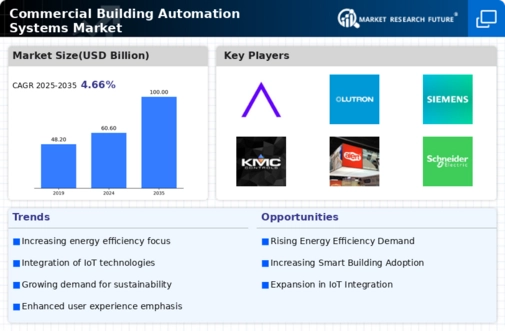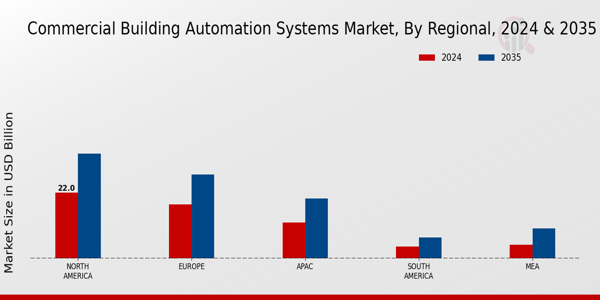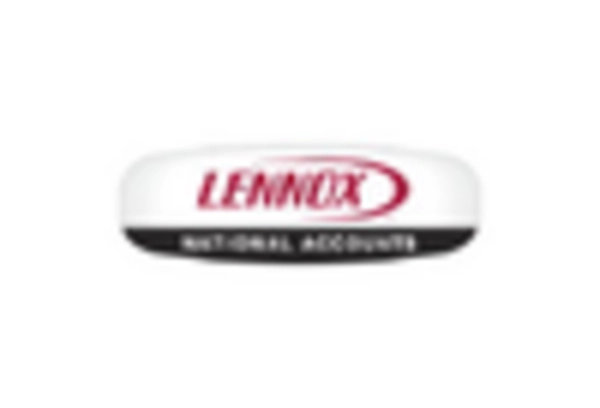Regulatory Compliance and Standards
The Commercial Building Automation Systems Market is also influenced by the need for compliance with various regulations and standards. Governments and regulatory bodies are increasingly mandating energy efficiency and sustainability measures in commercial buildings. This regulatory landscape compels businesses to adopt automation systems that not only meet these requirements but also enhance operational efficiency. For instance, compliance with standards such as ASHRAE and LEED can lead to significant financial incentives, including tax breaks and rebates. Consequently, the demand for building automation systems that facilitate compliance is likely to rise. Companies are recognizing that investing in these systems is not merely a matter of regulatory adherence but also a strategic move to enhance their market competitiveness. The interplay between regulation and technology is expected to drive further growth in the automation systems market.
Technological Advancements in Automation
Technological innovations are propelling the Commercial Building Automation Systems Market forward. The advent of smart technologies, such as artificial intelligence and machine learning, is enabling more sophisticated automation solutions. These advancements allow for predictive maintenance, which can reduce downtime and extend the lifespan of building systems. Furthermore, the integration of advanced sensors and analytics tools enhances the ability to monitor and control various building functions, from HVAC systems to lighting. As a result, businesses are increasingly investing in these technologies to improve operational efficiency and occupant comfort. The market for building automation systems is projected to grow significantly, with estimates suggesting a compound annual growth rate of over 10 percent in the coming years. This growth is indicative of the critical role that technology plays in shaping the future of commercial building operations.
Integration of Smart Building Technologies
The integration of smart building technologies is a significant driver of the Commercial Building Automation Systems Market. As the Internet of Things (IoT) continues to evolve, the ability to connect various building systems and devices is becoming increasingly feasible. This interconnectedness allows for enhanced data collection and analysis, leading to more informed decision-making regarding building operations. The potential for real-time monitoring and control of systems such as lighting, HVAC, and security is transforming how buildings are managed. Market data suggests that the adoption of smart technologies can lead to operational cost savings of up to 25 percent. As businesses recognize the benefits of smart building integration, the demand for comprehensive automation solutions that facilitate this connectivity is expected to grow, further shaping the market landscape.
Rising Demand for Energy Management Solutions
The increasing emphasis on energy efficiency is driving the Commercial Building Automation Systems Market. Organizations are seeking to reduce operational costs and minimize their carbon footprint. According to recent data, energy management systems can lead to a reduction in energy consumption by up to 30 percent. This trend is particularly evident in commercial buildings, where energy costs represent a significant portion of operational expenses. As a result, the demand for advanced automation systems that facilitate real-time monitoring and control of energy usage is surging. These systems not only optimize energy consumption but also enhance overall building performance, making them a critical component in the strategy of many businesses aiming for sustainability. The integration of energy management solutions into building automation systems is likely to continue shaping the market landscape.
Increased Focus on Occupant Comfort and Safety
The emphasis on occupant comfort and safety is becoming a pivotal driver in the Commercial Building Automation Systems Market. As businesses strive to create conducive work environments, the integration of automation systems that enhance air quality, lighting, and temperature control is gaining traction. Research indicates that improved indoor environmental quality can lead to increased productivity and employee satisfaction. Moreover, safety features such as automated access control and surveillance systems are becoming essential components of building automation. The growing awareness of health and safety standards is prompting organizations to invest in systems that ensure a secure and comfortable environment for occupants. This focus on well-being is likely to influence purchasing decisions, driving demand for advanced automation solutions that cater to these needs.

















Leave a Comment